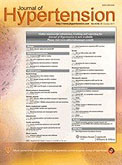Honetschlägerová Z, Sporková A, Kopkan L, Husková Z, Hwang SH, Hammock BD, Imig JD, Kramer HJ, Kujal P, Vernerová Z, Chábová VC, Tesař V, Cervenka L. J Hypertens. 2011 Aug;29(8):1590–601. IF: 3.980

Abstract:
OBJECTIVE: In the present study, we compared the effects of treatment with the novel soluble epoxide hydrolase (sEH) inhibitor (c-AUCB) with those of the AT1 receptor antagonist losartan on blood pressure (BP), autoregulation of renal blood flow (RBF) and on glomerular filtration rate (GFR) and the pressure-natriuresis relationship in response to stepwise reduction in renal arterial pressure (RAP) in Cyp1a1-Ren-2 transgenic rats. METHODS: Hypertension was induced in Cyp1a1-Ren-2 rats through dietary administration for 11 days of the natural xenobiotic indole-3-carbinol (I3C) which activates the renin gene. Treatment with c-AUCB and losartan was started 48 h before initiating administration of the diet containing I3C. Rats were prepared for renal functional studies to evaluate in-vivo renal autoregulatory efficiency when RAP was gradually decreased by an aortic clamp. RESULTS: I3C administration resulted in the development of severe hypertension which was associated with markedly lower basal RBF and GFR and substantially impaired autoregulatory efficiency as well as a suppression of the pressure-natriuresis relationship when compared with noninduced rats. Treatment with c-AUCB significantly decreased BP, improved autoregulatory efficiency of RBF and GFR and the slope of pressure-natriuresis relationship. Treatment with losartan completely prevented the impaired autoregulation and pressure-natriuresis relationship as well as the development of hypertension in I3C-induced rats. CONCLUSION: Our present findings indicate that chronic treatment with the sEH inhibitor c-AUCB substantially attenuates the development of malignant hypertension in I3C-induced rats likely via improvement of the renal autoregulatory efficiency and the pressure-natriuresis relationship.
-mk-
